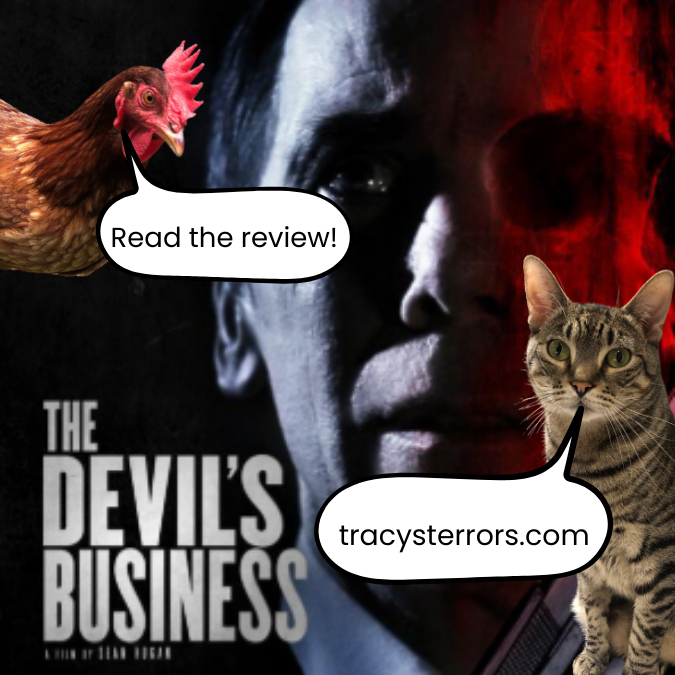
Early in Sean Hogan’s 2011 horror-noir film, The Devil’s Business, newbie hitman Cully urges his hardened mentor, Mr. Pinner, to tell him about the craziest thing he’s ever encountered on the job. Cully’s vibrating with nerves and trying to kill time: the two men are sitting in the home of their target Mr. Kist, waiting for him to return from the opera. And in Kist’s dark, creepy house, marked by a makeshift satanic altar on the dining room table, they could both use a little distraction. So Mr. Pinner, our main character, obliges, telling the tale of Valentina, a stripper he eliminated at the behest of their boss. Soon after dumping her body in the Thames, he heard from Eddie, her former lover and manager, that her ghost was at the club, spooking other dancers and taking the stage after hours. This strange story–its content as well as the way it’s presented–captures everything that makes Hogan’s film such a success.
First off, the scene could be straight out of a stage production. Starkly lit from the side with his features cast in shadow and staring fixedly into the distance as if he could see the past emblazoned there, Pinner delivers his monologue with the kind of theatrical intensity that defines the film as a whole–indeed, The Devil’s Business feels like a minimalist play performed in a black box theater, stripped down and earnest in a way that we don’t often see in the genre. There are never more than two actors on screen at time, and all of the unities are observed, with the horror unfolding over the course of one night at a single location. In other films, such economy might feel cheap, a necessary evil in order to get a movie made on a tight budget. Here, on the other hand, the compactness is integral to the success of the story, creating a claustrophobic atmosphere that’s the perfect counterpoint to the enormity of the film’s revelations. Skillfully balancing oppositions, Hogan uses small spaces and restrained conversation to disclose big truths about the unseen world and its kingpin–the Devil.
The Valentina monologue hints at cosmic forces that Pinner immediately disavows, setting up the film’s major conflict. A staunch rationalist, he insists that the haunting can’t be real–yet, he handles the anecdote as he would a loaded gun: with great care and seriousness. There are personal reasons for this, revealed later in the film, but his solemnity also seems tied to the story’s underlying threat. If it were true that the dead left a spiritual trace, then it would blow a hole in the materialistic worldview on which his career is built. For Pinner, a hitman is a hammer that crushes without thought or feeling, a dumb instrument wielded by others whose calculations are wholly of this world. As he repeatedly tells the morally conflicted Cully–perhaps too much, it gets a little tedious–in their line of work, there is no right and wrong; just bodies acting on other bodies with neither guilt nor sentiment. It’s this mechanistic view of murder that allows him to sleep at night, and it’s precisely this self-protective fiction that a ghost could destabilize. A messy spiritual residue lingering after a clear-cut kill would upset all of his assumptions and render his position untenable. If he treats Valentina’s tale like a metaphorical loaded gun, it’s definitely Chekhov’s: once introduced, we know that eventually it will go off. And go off it does. In Kist’s house, Pinner encounters phenomena that he can’t explain, and his dogged insistence on reason in the face of the irrational creates a compelling piece of existential drama.
So far I’ve made The Devil’s Business sound about as fun as a performance of Sartre’s No Exit, but it’s not as serious as all that. A bumbling idiot with a ludicrously large gun, Cully provides well-paced comic relief, and Pinner’s idiosyncratic sartorial choices–in particular, his mickey mouse gloves and super-sized starched collar–made me laugh. What really breaks the film out of the theatrical blackbox, though, is its plunge into spectacular gore and its surreal, almost Lynchian use of a little person. I won’t give too much away, but suffice it to say that special effects artist Dan Martin leaves nothing to the imagination–in the best possible way.
Coming in at just under 70 minutes, The Devil’s Business is a lean, mean, terror machine and well worth you time. If you missed it back in 2011, you can catch it now on Shudder.